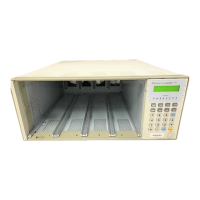Programmable DC Electronic Load 6310 Series Operation & Programming Manual
above the current of the Load. The over current (OC) and current error (CE) status
register bits are set when the OC condition occurs, and will remain set till they are reset.
The Load module will appear OCP when over current protection occurs.
z Over power
The overpower protection circuit is set at a level slightly above the power range specified
in the Load specifications. The over power (OP) and power error (PE) status register
bits are set when the OP condition occurs, and will remain set till they are reset. The
Load module will appear OPP when overpower protection occurs.
z Over temperature
Each Load has an over temperature protection circuit, which will turn off the load if
internal temperature exceeds the safety limit. The over temperature (OT) and
temperature error (TE) status register bits are set when the OT condition occurs, and will
remain set till they are reset. The Load module will appear OTP when over temperature
protection occurs.
z Reverse Voltage
The Load conducts a reverse current when the UUT polarity connection is not correct.
The maximum safe reverse current is same as the Load rated current. If the UUT
reverse current is over the rated current of Load, the Load may be damaged. If a
reverse voltage condition is detected, you must turn off the power to UUT immediately,
and correct the connection. The reverse voltage (RV) and voltage fault (VF) status
register bits are set when the RV condition occurs, and will remain set till they are reset.
The Load module will appear REV when reverse voltage protection occurs.
All of the protection features will latch when they are tripped. When any of the protections
occurs the module will turn off the load input, and beep till you remove the condition and
reset the protection by pressing LOAD key on the module.
a CAUTION
To protect the Electronic Load from possible damage, the input voltage must not exceed the
maximum input voltage rating specification. In addition, the Load + terminal potential must
be higher than the − terminal potential.
3.13 Save/Recall Setting
The Electronic Load setting for all channels can be saved and recalled for various test setup
use. This simplifies the repetitive programming of different things. The present setting of
mode parameters (CC, CR, CV), programs and power on status (DEFAULT) can be saved in
the EEPROM using the SAVE key. Later you can recall the settings from the specified file
via RECALL key. The SAVE and RECALL keys affect all channels simultaneously.
3-12

